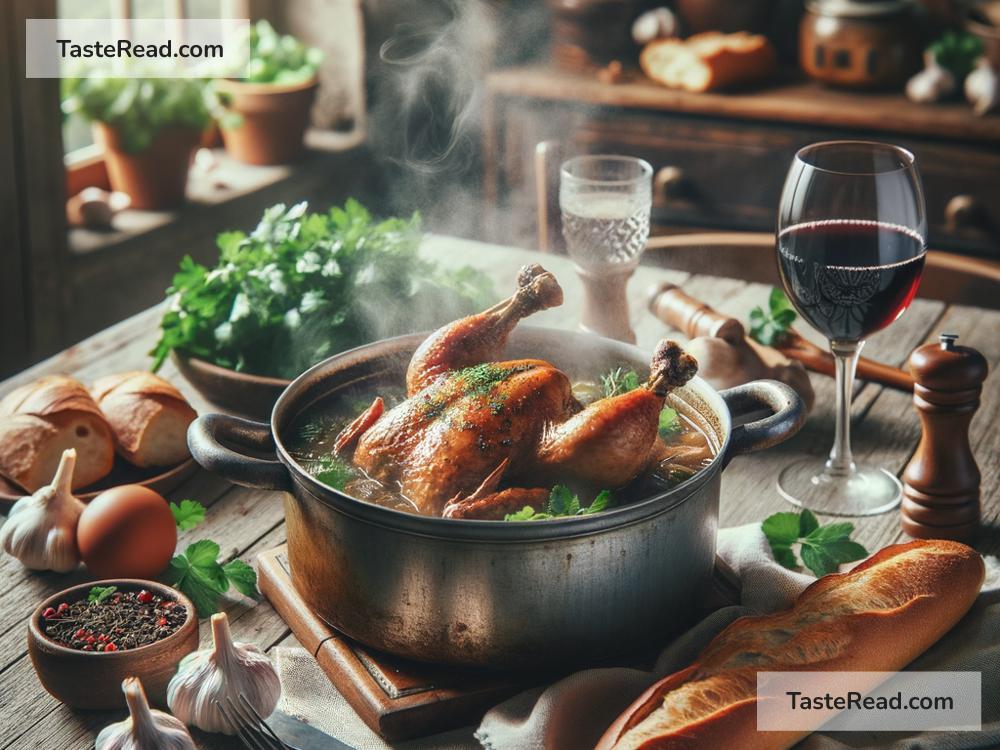The Story of the French Coq au Vin
French cuisine is celebrated all around the world for its sophistication, rich flavors, and memorable recipes. Among the many iconic dishes France has given us, Coq au Vin holds a special place. This traditional dish, which translates to “rooster in wine,” is not only delicious but also carries a fascinating history. Let’s dive into the story behind Coq au Vin and how it has become a symbol of French culinary tradition.
What Is Coq au Vin?
Coq au Vin is a rustic French dish made by slow-cooking chicken (usually a rooster originally) in red wine, along with ingredients like bacon, onions, garlic, mushrooms, and sometimes carrots. The wine acts as both a tenderizer and a flavor booster, resulting in meat that is juicy, deeply flavorful, and irresistibly aromatic. The dish is traditionally served with crusty bread or over noodles, potatoes, or rice, allowing you to soak up the rich sauce.
While it is now a dish reserved for special occasions or leisurely dinners, Coq au Vin started as a practical meal meant for making tough meat more palatable. It showcases a perfect blend of simple, humble ingredients and culinary skill.
The Origins of Coq au Vin
The exact origins of Coq au Vin are not entirely clear, and the dish has roots that go back hundreds—even thousands—of years. The concept of slow-cooking meat in wine is ancient, possibly dating back to Roman times when winemaking was a widespread tradition across Europe. However, the dish in its recognizable form is said to have emerged in France.
Legend has it that Julius Caesar and his Roman soldiers may have inspired Coq au Vin. The story goes that during their conquest of Gaul (modern-day France), Caesar was gifted a tough old rooster by French villagers. In return, he shared a recipe for cooking the bird in wine to make it tender and flavorful. While this tale is more folklore than fact, it does reveal the dish’s deep roots in French history.
More realistically, Coq au Vin was a farmer’s creation. In rural areas of France, roosters were kept for breeding purposes. Once a rooster aged and was no longer useful, it became tough and hard to eat. French cooks needed a way to transform this challenging meat into a satisfying meal. The solution? Slow-cooking the rooster in wine, spices, and other flavorful ingredients to soften the meat and create a hearty, delicious dish. Over time, this simple farm recipe evolved into the beloved gourmet dish we know today.
Regional Variations of Coq au Vin
France is known for its diverse regional cuisines, and Coq au Vin is no exception. While the classic version uses Burgundy red wine, different areas of France have developed their own interpretations based on local wines and ingredients. Here are some examples:
-
Coq au Vin Rouge (Red Coq au Vin):
The traditional and most famous version uses red wine, particularly Pinot Noir from the Burgundy region. It’s rich, earthy, and pairs beautifully with the flavors of mushrooms and bacon. -
Coq au Vin Blanc (White Coq au Vin):
In regions like Alsace and Jura, cooks use white wine instead of red, resulting in a lighter sauce that’s just as delicious. This version often incorporates cream for extra richness. -
Coq au Vin Champagne:
In the Champagne region of northeastern France, sparkling wine is sometimes used to prepare the dish, giving it a distinctive and festive flair. -
Coq au Riesling:
Alsace, known for its white Riesling wine, has its twist on the dish by infusing the chicken with Riesling’s fruity and floral notes.
Each version reflects the unique terroir and character of the region where it’s made, highlighting the adaptability and creativity of French cuisine.
From Tradition to Global Fame
Coq au Vin may have begun as a humble countryside dish, but over time, it gained recognition both inside and outside of France. In the early 20th century, as French cuisine became a hallmark of fine dining worldwide, traditional dishes like Coq au Vin were showcased as culinary treasures.
One of the people responsible for its international fame was Julia Child, the American chef and TV personality who adored French cooking. Her cookbook, Mastering the Art of French Cooking, introduced Coq au Vin to American home kitchens in the mid-20th century. She made the dish approachable, proving that anyone could recreate the flavors of France at home. Her love for Coq au Vin helped cement its reputation as a global classic.
How Coq au Vin Is Enjoyed Today
Today, Coq au Vin is considered a comfort food and a staple of French cuisine. While it may no longer be made with rooster—chicken is the common choice—it still stays true to its roots. Preparing Coq au Vin requires patience, as the dish is meant to be slow-cooked to perfection, but the end result is well worth the wait.
For many, cooking and eating Coq au Vin is a way to celebrate tradition and the art of food. Whether you’re dining in a cozy bistro in France or making it at home with friends and family, Coq au Vin brings people together with its warmth and simplicity. Its story reminds us that even the most humble beginnings can lead to something extraordinary.
So, the next time you enjoy a plate of Coq au Vin, think about the journey it has taken—from a clever farmer’s solution to tough meat, to a global ambassador of French cuisine. Behind every bite lies history, tradition, and the enduring magic of wine and good food. Bon appétit!


